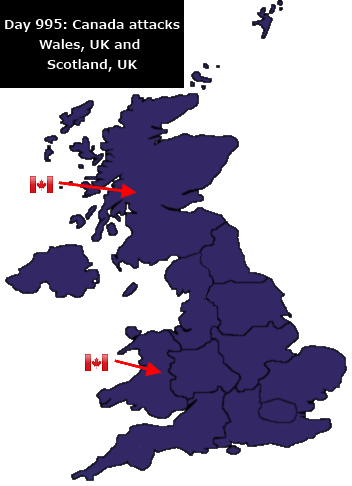Canada-UK War
| ||||||||||||||
The Canada-United Kingdom war, also known by the Canadian Armed Forces as Operation Single Malt, began on 10 August 2010 at 19:01 with a Canadian declaration of war and the immediate attack on two regions of the British mainland.
Contents
Operation Single Malt
Country President, Acacia Mason, announced to the citizens of Canada that he had opened two battles with the United Kingdom following discussions with "senior CAF officials, TCO commanders, and Praetor HQ".[1]
The declaration of war and invasions of Scotland and Wales, both of the United Kingdom, triggered no less than 6 MPPs and has meant that Canada is now involved in a war with a vastly superior sized enemy force.
The Canadian president believes that this war may kick-start the economy as his previous experience has shown war to fuel the economy.[2]
Timeline
Day One
The first two battles seemed to set the scene for the war as a whole. Canada invaded the United Kingdom on two fronts, through Scotland and Wales. It became clear quickly however, that the Canadian Forces would be focusing on Scotland and turned the situation from a total failure with just an hour left until the battle was decided making the whole affair much more interesting to the observer.
In the final hour, tiles were captured by many Canadians and they approached the capital city, Edinburgh, for an assault on the central victory objective. Canadian forces turned the battle around in an extraordinary way to be in control of the regional capital and the region as the battle drew to a close.
The battle in Wales was a much less muted affair with the United Kingdom securing the region while the Canadians enjoyed their spoils from Scotland.
Day Two
The next set of battles were placed the following day. A total of three battles were set on day two. Canada attacked more regions of the United Kingdom, by attacking both Northern Ireland (in the hope of giving it to Ireland afterwards), and also North East of England approximately 30 minutes after Canada's victory in Scotland.
However, later on in the day, a third battle emerged. Russia attacked Scotland which was in current eCanadian control, in the attempt of winning it back, and gaining the region for United Kingdom again. Canada planned to defend Scotland on Day Three.
The first battle to end was that in Northern Ireland which Canada comprehensively won. They easily controlled a majority of the region and the capital. After a surprise turnaround, Canada also decided it was going to attack North East of England, within 30 minutes of the previous Northern Ireland battle finishing. Canada was again successful in conquering the target region.
Day Three
The first battle of Day Three for Canada took place in Scotland where Russia attacked it, trying to get it back to the United Kingdom, as it was one of their regions. Within the last hour of battle, Canada had gone for 25% of the tiles + Capital, to no tiles at all, and then within the final few turns, Canada was able to co-ordinate with EDEN countries on help, which all in all, gave them enough manpower to secure Scotland. Scotland was then attacked by the United Kingdom after the battle against Russia finished.
The second battle launched was in the region of Yorkshire & Humberside which was started in the later evening of Canada's Real Life Day. Following that, an attack was placed in Vestlandet to attack as well.
Day Four
The battles in Day Four, consisted of Scotland, Yorkshire & Humberside, and Vestlandet, all of which are regions (original or conquered) of the United Kingdom. Canada got off on a rocky start in Day Four, as they lost Scotland to the United Kingdom near the end of the battle.
Day four of the hostilities ended on a high for Canada as they comfortable conquered Yorkshire & Humberside and with the help of EDEN forces, conquered Vestlandet.
Day Five
The fifth day of hostilities passed without incident as Canada protected Vestlandet from the resistance forces of Norway. Meanwhile, they helped in the attacks on Dublin, Ireland where the Irish forces were trying to retake their capital region.
Day Six
The sixth day saw Canadian forces secure three regions, Scotland, Trondelag and East Midlands. Scotland was secured earlier by the United Kingdom on day four. Trondelag was an EDEN target while East Midlands was a Canadian target. All three were successfully secured by the forces loyal to the Canadian cause. Canada then attacked Wales, in which the United Kingdom retreated the battle.
Day Seven
The seventh day resulted in the retreat of East of England to Canadian forces and a Resistance war in Trondelag. Canada lost Vestlandet to the Russians and the United Kingdom restarted hostilities in Scotland and the East of England.
Day Eight
The Eighth Day had two battles for Canada to fight in. The first in North West of England and the second in West Midlands, both of which ended in primetime for Canada. The British were almost able to secure both regions, but in overtime Canada was able to successfully obtain both regions from the United Kingdom, as help was sent in from the United States.


